http://www.youtube.com/watch?v=NUi1lqKNf6s
It was billed as one of the hottest days of the summer. Temperatures in south Texas were forecast to be somewhere between 108 degrees and 114. There wasn’t a cloud in the sky, and not a puff of breeze to move the humid air. Without taking the proper precautions, the survival time of an average human in those conditions would be measured in hours. Sensible people spent the day indoors, enjoying their air conditioning and perhaps some Netflix. But for me, nothing short of a hurricane keeps me away from a shooting competition . . .
The Texas Tactical organization runs some of the local matches in the San Antonio/Austin area, and they’re the ones responsible for the carbine competitions. I’ve shot them before at the Cedar Ridge range and in my experience, they can be a little screwy. Most 3-gun competitions use a version of the USPSA rulebook as the basis for their rules, with the specifics differing between each individual match as there’s no central governing body for the sport. For this match, they decided to go with a modified version of IDPA rules instead. That means shooting needs to be done behind cover and “tactical” reloads require you to retain the magazine among other crazy rules.
USPSA and IDPA split from a common competition style back in the 1990s, and while USPSA became increasingly more focused on the “game” aspect, the IDPA rules tried to be as “practical” as possible and applicable to real life defensive gun uses. But the rulebook has gotten so full of inanities in the last few years that some describe IDPA as “the lawyer’s shooting competition.” Stages are also typically much more scripted, allowing little to no ability for the shooter to choose how to shoot the targets, let alone what order.
I’d been bitten by a couple of these rules in the past, so I started the day out trying to avoid those same old traps. Unfortunately, trying to avoid the old ones only led me into some new ones.
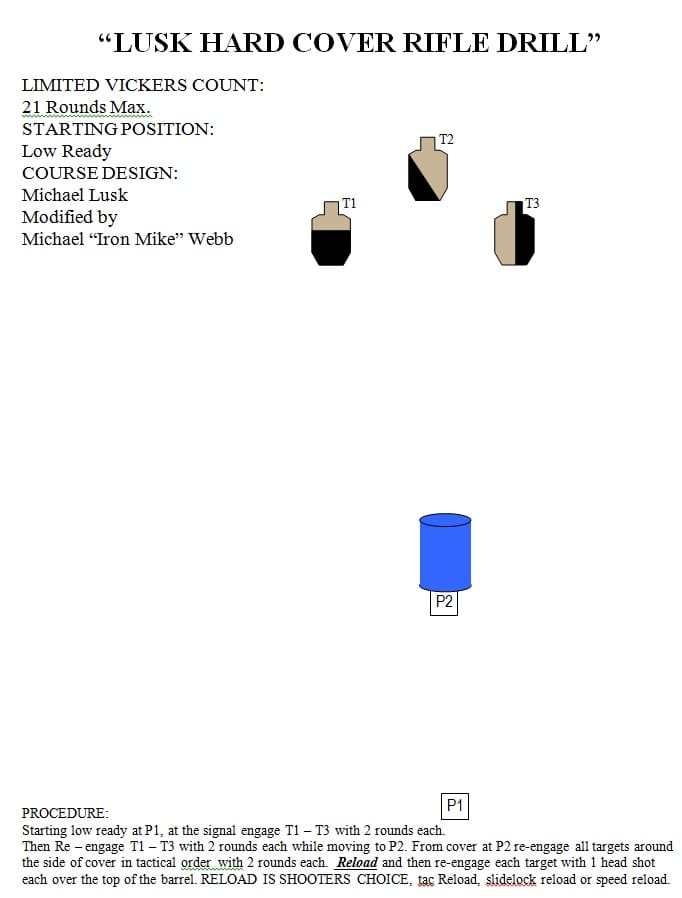
The first stage had three targets and required two rounds each from a standing position, two more rounds moving to a barrel, another pair from around the barrel and then, after a mandatory reload, one headshot each from on top of the barrel. Oh, and it was a limited-round count stage, so any shots fired above the required number would count as a procedural penalty. The only option here was that the shooter could choose what kind of reload to do, so that gave us the option to download our magazines from full capacity to whatever we wanted.
The last time I tried a stage with a limited round count I loaded up my mags and completely forgot that I was supposed to stop shooting at some point. That netted me a plethora of penalties, and I wanted to avoid that, if at all possible. So I only loaded enough rounds to complete the stage. BIG mistake there, as I had loaded up the last of my crappy ammunition in that magazine instead of my fresh, new Winchester 5.56 ammunition that had arrived the week before. On the very last round of the stage, the gun went click instead of bang. I was out of ammo before finishing the stage.
As much as I hate to say it, every time I use American Eagle ammo, I seem to have a failure to fire malfunction. I’ve never had a problem with Winchester, though – it runs fine every time. When I can get my hands on some, that is. So, that FTF alone netted me a “failure to engage” penalty of +5 in addition to the miss (another +5), for a total of 5 additional seconds before the scoring even started. Not fun.
The next stage involved some shooting around barrels, and that proved to be a bigger challenge than I thought.
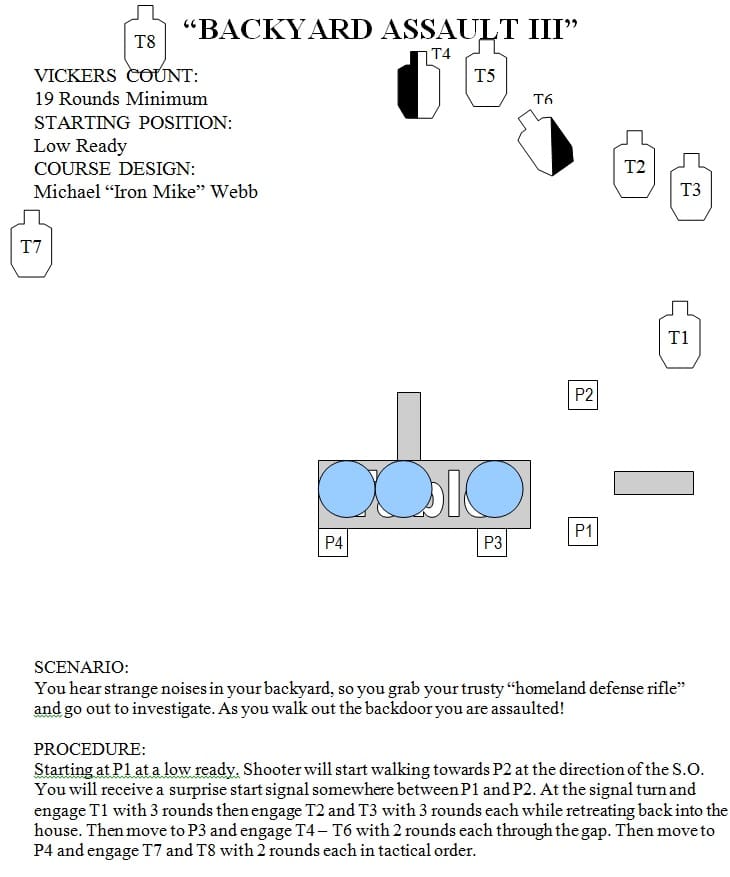
Good shooters like to put a little bit of distance between themselves and any obstacles. Standing only a few inches from a barricade or a barrel limits your ability to move quickly, and increases the time it takes to get into position and then move on to the next target. So when I set up behind the barrels, I naturally slid to a stop about a yard from the table, giving me enough room to maneuver without being too far away.
But because we needed to shoot the final two targets from behind cover while “slicing the pie,” I let the muzzle of my gun get too close to the side of the plastic barrel. I skipped a round off the side of the barrel, sending it off into the weeds somewhere instead of slamming it through the cardboard. Chalk up another +5 for a miss.
The next two stages ran well. They were very straightforward and didn’t have any real tricks. Looking at the scores, I was going back and forth with the other top shooter in my division (Alan) for the top spot all day long, sometimes with me coming out on top and sometimes with him uber alles. And the only people beating us were the guys running the open division handguns and ignoring the rifle bits altogether.
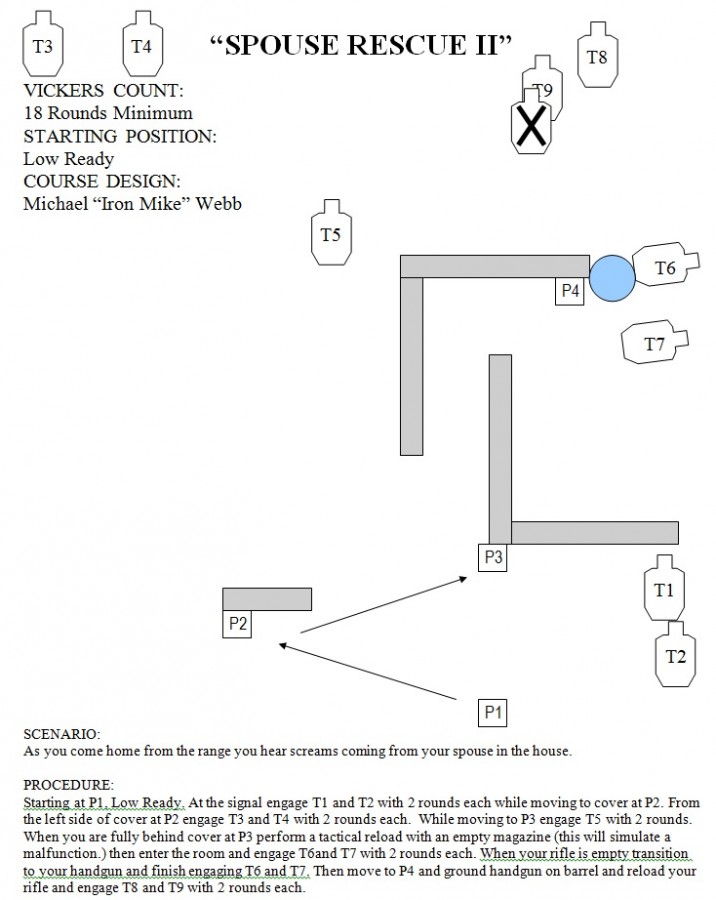
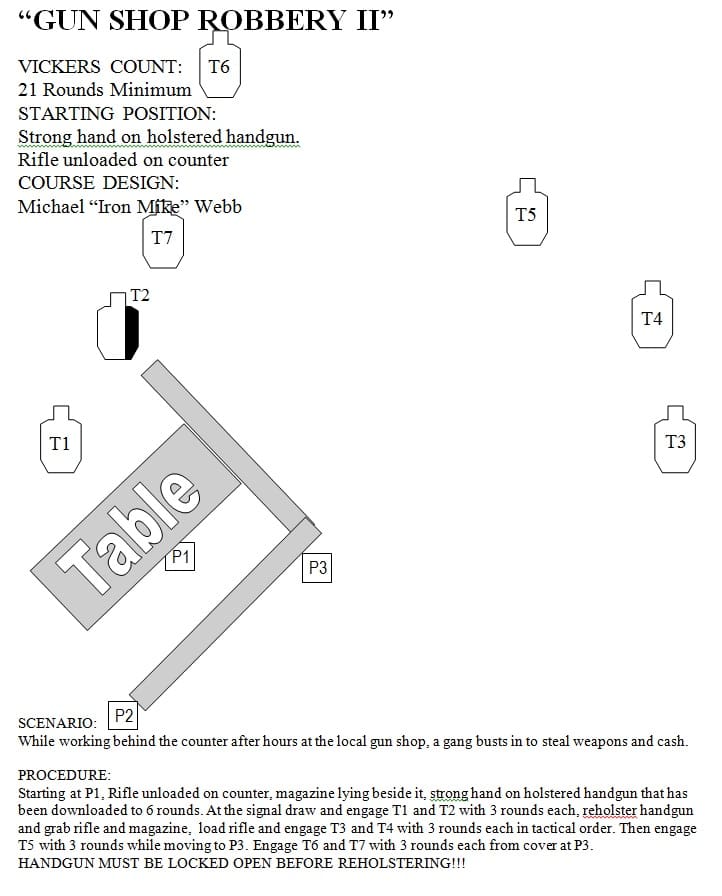
The only issue I kept running into was remembering which targets required three rounds and which only needed two. The stages kept flip-flopping, some requiring a mixture of two and three rounds per target, and it got a bit confusing. Usually with 3-gun, two hits is the most you’ll ever need on a target. And if you want a shooter to shoot more, you just pop another piece of cardboard up. But with this heavily-scripted form of competition, remembering which target needs how many rounds was as big a part of the game as anything else.
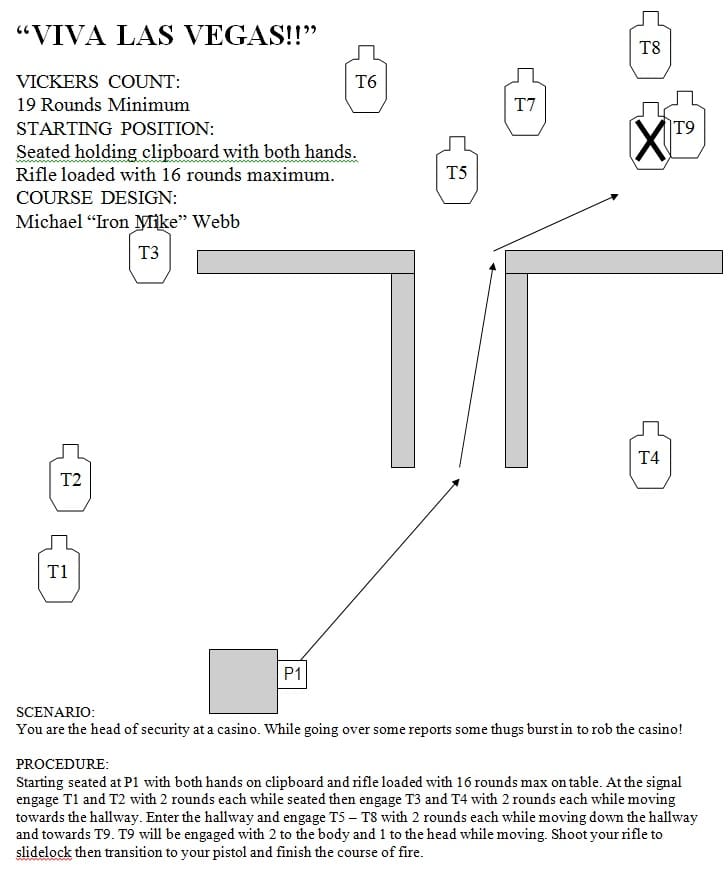
This confusion finally cost me big-time in the last stage. The design had you begin from a seated position behind a couple barrels and plugging two targets from there. Then two more on the move before heading down a hallway. Three targets were at the far end and needed two more rounds each, then one more target for the rifle before transitioning to the handgun for a Mozambique drill (two to the body, one to the head) on a target with a no-shoot in front of it. It was a pretty heavily-scripted affair, and required the shooter to remember a lot of information.
After being out in the sun all day, I had chugged through about seven liters of water, but was still on the verge of heatstroke. My brain wasn’t firing on all cylinders and I was having trouble remembering the plan I had set for the stage. So when the buzzer went off, I instinctively stood up and wanted to start shooting. The RO had to remind me to shoot from the chair, and that cost me about three seconds of wasted time.
And it didn’t get any better. As I stood up and started moving away from the chair, I forgot if the targets needed three rounds or whether two were enough. Again, the RO had to remind me to move on and I figured two was fine. Another three seconds wasted thanks to my baking brain not cooperating.
I should have won my division for the day. And if you remove the penalties from the various and sundry mistakes I made (coming up a round short, hitting the barrel, and the mental issues) I would have easily sailed into first place. But as I’m slowly coming to understand, while speed and accuracy may be the difference between the bottom of the list and the middle of the pack, working your way up to the top of the sheet is more about eliminating your own mistakes rather than actually shooting faster. One bad mistake can open the door for the other top competitors, like Taran Butler did at the Hornady zombie match when he gave up first place to FNH USA’s Larry Houck.
In a game where the top ten shooters are often within five seconds of each other’s time, mistakes can really hurt. But thankfully, each competition I go to I learn a little more and make fewer mistakes.

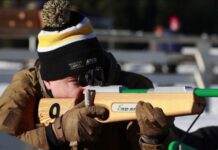


It might seem counter-intuitive, but it seems from your article that these scripted, unusual stages actually forced you to think more. Perhaps changing up the routine will help keep your mind limber.
Where is this club located? I am dying inside shooting indoors at Red’s all the time…
Maybe you have to “think” more, but only about arbitrary stuff that has no practical purpose (like they want in IDPA) nor about how to best shoot a stag (like in USPSA). To me it sounds like an arbitrary ruled competition, the worst kind. At least in outlaw three gun they generally keep the same rules throughout the competition, this seems like they flip flopped and forced odd and unusual as well as tactically unsound shooting.
This was held at the Austin Rifle Club in Manor, right off of 290
a “carbine” match? There was more than 10 rounds in those magazines!!
I watched the vid and it looked like you were a bit slow, I was wondering if it was an ailment. I see now the rules slowed you down.
Cool wirte up. Ill read it again at home tonight.
Yeah, it makes more sense in IDPA rules to take the extra second and hit the center scoring zone than to rush through and just throw two rounds anywhere on the paper.
I dont shoot in competitions but wouldn’t a red dot/reflex be better than that scope you got on that rifle…at those ranges? I would think an Eotech would be perfect and much faster. Heck out to 100 I would rather use a red dot or reflex.
I believe that is a variable power (CQBSS?), so he can tune it down to 1x or 1.5x and shoot the close-up stuff.
Neat optics to be sure. However, I do prefer aimpoints because they are easier to shoot in awkward positions where attaining good eye relief is difficult.
It’s a 1-something power scope. 1x is just fine for up close and personal shootin.
I’m using a Leupold Mark AR Mod 1 variable scope with the SPR reticle. It’s a 1.5 – 4x scope, and it does a great job of letting be shoot close targets as well as long distance.
I’d love to have used a red dot, but it’s such a pain to swap between optics for every match that I just pick one scope and roll with it for the season.
Nick,
These matches are great and a lot of Fun to shoot, but I agree, they can be to scripted, (read too much thinking). But honestly Three gun is a little to “Hot Roddish” for me and a little unrealistic, not to mention, very costly to get started.
I like Mike’s Carbine matches more, due to they resemble more of what I have seen and done in the military, every one of the people I have invited to this match love it because of that. I like that fact that you can use an EO Tech or a Red dot or Trijicon ACOG. I am just not a fan of putting a Scope on an AR, it just doesn’t feel right and the AR wasn’t meant to be used with a scope for engagements inside 300m. I agree that it does work, but if were meant for a scope, there would be 570,000 ARs in the Army with scopes on them, and there just aint! A lot of them do have an optic though.
I think the middle ground is somewhere in between the two disciplines. Maybe a Cardboard Target with a steel plate behind the “kill zones” (Head and/or Center mass) that forces the shooter to shoot till the threat goes down is really the answer.
Mike’s Stages do have a lot of different variables though and that is cool. But the Mozambique thing, no matter how cool, is a kind of a waste. Putting three in center mass is going to at least, at a minimum eliminate your threat from making any kind of future move in your direction. Making an excess move to the head only allows for another chance to miss, the gun rises the more you pull the trigger anyways. I tend to like the fact that you have to utilize cover, but what I really think is missing is the “Violence to Action” Keep pressing forward, pulling the trigger and eliminating the threat, clearing the objective with well place direct fire will never be replaced with some of the things a person sees in three gun matches or even some of Mike’s matches. Forcing someone to seek cover and reload is an enormously important skill too, three gun forces you to learn to reload fast, but not behind cover, so both have their goods and bads.
Bottom line, Mike’s matches are more realistic for me,
Just my two cents,
Great write up Nick!
” I like that fact that you can use an EO Tech or a Red dot or Trijicon ACOG. I am just not a fan of putting a Scope on an AR, it just doesn’t feel right and the AR wasn’t meant to be used with a scope for engagements inside 300m. I agree that it does work, but if were meant for a scope, there would be 570,000 ARs in the Army with scopes on them, and there just aint! A lot of them do have an optic though.
”
“Feel Right”? “Meant to”? What do you think an AGOG is? It’s a scope. The packaging may look different, but that is what it is.
Jim S,
It’s also a reflex sight!
That was my first match of any kind other than sporting clays, and I had a blast! Not having been exposed to the other types of matches, I thought the scenarios were fun.
I like that a newb like me can shoot his AK with iron sights on the same course as people like Nick and Alan with their nice, nice guns. That SCAR is sweet.
I did think it was a bit much though when Nick got picked up by the FN helicopter after the match. Dust in my eye.
Comments are closed.